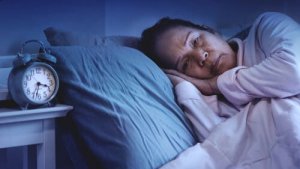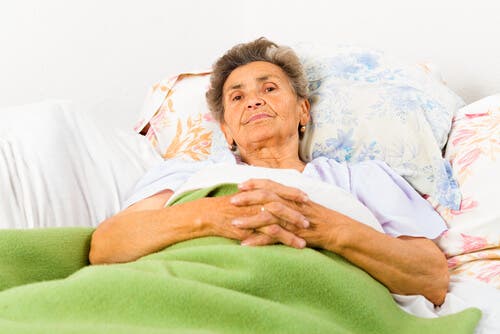Alzheimer's Disease and Sleep Pattern Changes


Written and verified by the doctor Elisa Martin Cano
Alzheimer’s disease is the leading cause of dementia in the world. Among the many other symptoms, it can cause are sleep disorders. Overall, it’s common for different stages of the disease to cause changes in sleep patterns and quality.
In this article, we’ll tell you about the most common sleep changes that people with Alzheimer’s disease may suffer from.
What is Alzheimer’s disease?
Alzheimer’s disease is the most commonly occurring dementia in the world population. Around the world, about 48 million people suffer from it. Plus, given the increase in life expectancy, it’s estimated that the cases will increase a lot in the next few years.
By definition, it causes a cognitive deterioration that affects the normal life of the person, either in a personal, social, or work environment. In this condition, protein deposits form in and around the neurons, as well as cell death and failures in neuronal communication.
Clinically, the disease causes memory loss. This is the main symptom, and for good reason, but it can manifest itself in many other ways. Some of the symptoms that accompany memory loss are changes in language and behavior. This can also imply a loss of sleep.

You might be interested in: The Differences between Dementia and Alzheimer’s
Sleep changes in Alzheimer’s disease
Normally, sleep disorders evolve along with the disease. However, the type of changes and the impact they have on the patient have to do with the type of person, and the stage of the disease they are in.
Sleep changes in Alzheimer’s disease can be divided into different types:
- Changes in sleep architecture: This is related to the sleep phases. In people with Alzheimer’s, deep sleep phases are reduced. Micro awakenings and awakenings increase. There are also fewer phases of REM sleep and more phases of non-REM sleep.
- Changes in breathing: This may include snoring, hypopnea, and Obstructive sleep apnea/hypopnea syndrome (OSAHS). It has been found that patients with the disease have a much higher rate of these conditions than unaffected people. Researchers will have to study them independently since the treatment for these conditions is specific and would be parallel to the disease.
- Restless leg syndrome: This is when the person has to move their legs constantly or periodically when they are going to sleep. Additionally, it can be accompanied by nightmares.
Sleep pattern changes
Alzheimer’s disease causes a change in your biological rhythms. This evolves along with the disease, making it more noticeable as the disease advances.
The fact that your biological rhythms change causes drowsiness throughout the day. Patients may doze during the day and need to take naps. This can cause social problems to increase since it becomes harder to maintain conversations and relate with people normally.
Additionally, this drowsiness and sleeping during the day can cause the person to be less sleepy at night. This can cause them to wake up more, be restless, and walk around the house.

You might be interested in: Anatomy of Dementia: How is The Life of a Demented Patient?
Sundown syndrome in Alzheimer’s disease
One specific change in biological rhythms is sundown syndrome or “sundowning.” In it, patients with dementia start to experience worse symptoms near the end of the day, especially in behavior. Their restlessness and agitation may increase.
In addition to restlessness and nervousness, they may suffer hallucinations, delusions, inexplicable fear, or even fits of rage. Up to 20% of patients with dementia have episodes of this syndrome.
What to do about sleep
Although it’s the most known symptom of the disease, Alzheimer’s doesn’t just show itself in memory loss. Many symptoms can accompany the disorder, and they can show themselves differently in each patient. As always, it’s extremely important for each person to get a proper diagnosis, go to their checkups, and tell their doctor about all the symptoms they experience.
For each case, a specialist should be the one to decide what the best treatment is. With this type of disease, they may have to adjust the treatment several times to have the best effect.
All cited sources were thoroughly reviewed by our team to ensure their quality, reliability, currency, and validity. The bibliography of this article was considered reliable and of academic or scientific accuracy.
- Carvalho DZ, St Louis EK, Knopman DS, Boeve BF, Lowe VJ, Roberts RO, et al. Association of excessive daytime sleepiness with longitudinal β-Amyloid accumulation in elderly persons without dementia. JAMA Neurol. 2018 Jun 1;75(6):672–80.
- Alzheimer y sueño – Adsalutem Institute [Internet]. [cited 2020 Mar 10]. Available from: http://www.adsalutem.institute/salud-y-sueno/alzheimer-y-sueno/
- Mander BA, Winer JR, Walker MP. Sleep and Human Aging. Vol. 94, Neuron. Cell Press; 2017. p. 19–36.
- Custodio N. Alteraciones del sueño, envejecimiento anormal y enfermedad de Alzheimer. Rev Neuropsiquiatr [Internet]. 2017 Dec 21 [cited 2020 Mar 10];80(4):223. Available from: http://www.upch.edu.pe/vrinve/dugic/revistas/index.php/RNP/article/view/3236
- Trastornos del sueño en el anciano y en las demencias [Internet]. [cited 2020 Mar 10]. Available from: http://scielo.isciii.es/scielo.php?pid=S1137-66272007000200014&script=sci_arttext&tlng=pt
- Niu, Hao, et al. “Prevalencia e incidencia de la enfermedad de Alzheimer en Europa: metaanálisis.” Neurología 32.8 (2017): 523-532.
- Echávarri, C., and M. E. Erro. “Trastornos del sueño en el anciano y en las demencias.” Anales del Sistema Sanitario de Navarra. Vol. 30. Gobierno de Navarra. Departamento de Salud, 2007.
This text is provided for informational purposes only and does not replace consultation with a professional. If in doubt, consult your specialist.








